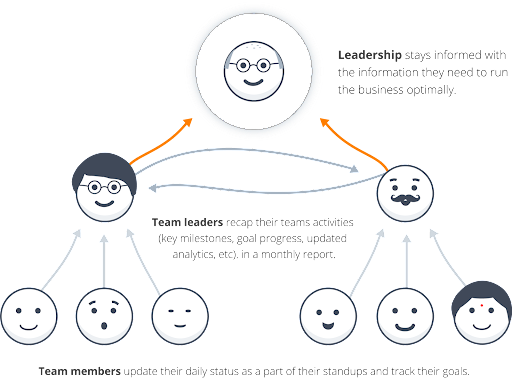 What makes for a happy, productive team? Before we answer that, let’s take it back a couple of decades.In the early 1990s, psychologist John Gottman wrote a book based on years of research that definitively answered an elusive question: What is the number one behavioral predictor of a successful marriage?The answer: positive feedback.Apparently, the couples that stay together tend to deliver five positive messages for every negative one. In the years since his revolutionary finding, Gottman’s study has been followed by countless others on the effects of praise and positive affirmation in various settings—at the gym, at home with kids, in schools.They all seek to solve the same puzzle that has managers and team leaders everywhere on the edges of their seats: How often should I praise employees? And then there are the other nagging questions that tend to accompany this one:
What makes for a happy, productive team? Before we answer that, let’s take it back a couple of decades.In the early 1990s, psychologist John Gottman wrote a book based on years of research that definitively answered an elusive question: What is the number one behavioral predictor of a successful marriage?The answer: positive feedback.Apparently, the couples that stay together tend to deliver five positive messages for every negative one. In the years since his revolutionary finding, Gottman’s study has been followed by countless others on the effects of praise and positive affirmation in various settings—at the gym, at home with kids, in schools.They all seek to solve the same puzzle that has managers and team leaders everywhere on the edges of their seats: How often should I praise employees? And then there are the other nagging questions that tend to accompany this one:- When is it beneficial to criticize, and how can you make it constructive?
- What’s the perfect praise-to-criticism ratio for creating happy, productive teams.
Increase Team Productivity and Performance
Automated Daily Standups, Check-ins, & OKRs.
14-day free trial. No credit card required.
Related Articles
11 Best Productivity Tools for Your Remote Tech Team
Want to Increase Productivity at Work? Here’s What Science Says
Remote Work Productivity – How to Be More Productive At Home
The Power of Positive Feedback for A Productive Team
 In one Gallup poll, researchers discovered that 61% of employees who hear about their strengths from supervisors are actively engaged at work. However, among employees whose supervisors focus on weaknesses, that number goes down to 45%. Faring worst were the employees who felt ignored altogether—only 2% were engaged.“Employees who are ignored feel like they don’t matter,” wrote the report’s authors. “They want to be part of something greater than themselves, and they want to know how they contribute to that something. They want to be heard, and above all, they do not want to be ignored.”Similarly, the results of another popular study show that the ratio of positive comments to negative ones is a crucial indicator of team success. The highest-performing teams averaged 5.6 positive comments for every negative one, while the lowest-performing had almost three negative comments for each positive one.Putting this past research to the test, leadership development consultants Jack Zenger and Joseph Folkman dug into their database of 50,000 leaders. After some number-crunching, they reported an interesting trend:Among the employees who were already performing above average, more than 60% still improved significantly after hearing about their strengths.“Only positive feedback can motivate people to continue doing what they’re doing well and do it with more vigor, determination, and creativity,” Zenger and Folkman say.“Perhaps that’s why we have found with the vast majority of the leaders in our database, who have no outstanding weaknesses, that positive feedback is what motivates them to continue improving.”Plus, people like getting feedback—at least, the kinds of employees who will eventually step up to take on important leadership positions. When behavioral statistician Joseph Folkman looked through more than a decade of research, he discovered that leaders who ask for feedback are substantially more effective than leaders who don’t. But here’s another thing…While managers may feel uncomfortable giving candid feedback, studies show this style of feedback is exactly what the majority of employees want. In 2014, Zenger and Folkman assessed employee attitudes towards “positive” and “corrective.” The study revealed that 57% of respondents preferred corrective feedback. And, when given thoughtfully, 92% believed negative feedback was effective in improving employee performance. Those same employees who favored constructive feedback also rated their managers higher for showing honesty and straightforwardness. Employees want to know how to improve their performance, and they want to know it sooner than their annual review (or else it risks slowing down their professional development).
In one Gallup poll, researchers discovered that 61% of employees who hear about their strengths from supervisors are actively engaged at work. However, among employees whose supervisors focus on weaknesses, that number goes down to 45%. Faring worst were the employees who felt ignored altogether—only 2% were engaged.“Employees who are ignored feel like they don’t matter,” wrote the report’s authors. “They want to be part of something greater than themselves, and they want to know how they contribute to that something. They want to be heard, and above all, they do not want to be ignored.”Similarly, the results of another popular study show that the ratio of positive comments to negative ones is a crucial indicator of team success. The highest-performing teams averaged 5.6 positive comments for every negative one, while the lowest-performing had almost three negative comments for each positive one.Putting this past research to the test, leadership development consultants Jack Zenger and Joseph Folkman dug into their database of 50,000 leaders. After some number-crunching, they reported an interesting trend:Among the employees who were already performing above average, more than 60% still improved significantly after hearing about their strengths.“Only positive feedback can motivate people to continue doing what they’re doing well and do it with more vigor, determination, and creativity,” Zenger and Folkman say.“Perhaps that’s why we have found with the vast majority of the leaders in our database, who have no outstanding weaknesses, that positive feedback is what motivates them to continue improving.”Plus, people like getting feedback—at least, the kinds of employees who will eventually step up to take on important leadership positions. When behavioral statistician Joseph Folkman looked through more than a decade of research, he discovered that leaders who ask for feedback are substantially more effective than leaders who don’t. But here’s another thing…While managers may feel uncomfortable giving candid feedback, studies show this style of feedback is exactly what the majority of employees want. In 2014, Zenger and Folkman assessed employee attitudes towards “positive” and “corrective.” The study revealed that 57% of respondents preferred corrective feedback. And, when given thoughtfully, 92% believed negative feedback was effective in improving employee performance. Those same employees who favored constructive feedback also rated their managers higher for showing honesty and straightforwardness. Employees want to know how to improve their performance, and they want to know it sooner than their annual review (or else it risks slowing down their professional development). What the Numbers Mean for Managers
 Should you avoid giving constructive criticism at all costs? Certainly not. However, tapping into the power of positive feedback can open the doors to a culture of camaraderie and make day-to-day achievements more visible and recognized.It also means that managers need to focus constructive feedback on those needing the most improvement, but don’t ignore your top performers either.Your top performers need feedback regularly, or else you can jeopardize your retention rates, something that can cost your company 400% of its annual salary.Regular one-on-ones and positive feedback guides your team in a positive direction and focus on individual employee goals. And sometimes it can be as simple as saying, “Great job!”. Saying affirmations to your employees don’t need to be earth-shattering to have an impact. Many of the positive comments analyzed for research include statements such as “I agree with that” and “That’s a terrific idea.”In other words, a little goes a long way.
Should you avoid giving constructive criticism at all costs? Certainly not. However, tapping into the power of positive feedback can open the doors to a culture of camaraderie and make day-to-day achievements more visible and recognized.It also means that managers need to focus constructive feedback on those needing the most improvement, but don’t ignore your top performers either.Your top performers need feedback regularly, or else you can jeopardize your retention rates, something that can cost your company 400% of its annual salary.Regular one-on-ones and positive feedback guides your team in a positive direction and focus on individual employee goals. And sometimes it can be as simple as saying, “Great job!”. Saying affirmations to your employees don’t need to be earth-shattering to have an impact. Many of the positive comments analyzed for research include statements such as “I agree with that” and “That’s a terrific idea.”In other words, a little goes a long way.Positive Feedback Benefits and How It Makes for a Productive Team
Employees benefit from regular one-on-ones and performance reviews. In fact, organizational psychologist Marcial Losada found that the ratio between positive and negative feedback in higher performing teams averages 6 to 1. In other words, each nugget of negative feedback must be countered by 6 pieces of positive feedback. Gallup performed a long-term study on the benefits of positive feedback. The study revealed that:Employees receiving regular feedback are more involved
67% of employees receiving positive feedback from managers were highly involved in their work. In contrast, only 31% of employees received mostly negative feedback, focused on weaknesses, felt lower levels of involvement.Employees are more productive
Among 530 teams, Gallup found that positive feedback boosts productivity. For example, teams receiving positive feedback from their manager were more than 12% more productive than teams not receiving any input.It increases profits
Another Gallup study found that companies regularly practicing positive feedback are nearly 9% more profitable than companies where regular feedback isn’t a priority.It reduces employee turnover
Positive feedback positively affects attrition rates. For example, one Gallup study found that positive feedback reduces the risk of employee turnover by 15%. Something as simple as a high five or quick “thank-you” can be enough to boost moods and motivations. But, what else can you do as a manager to boost employee morale and inject positive energy into the workplace?Increase Team Productivity and Performance
Daily Standups, Check-ins, & OKRs.
14-day free trial. No credit card required.
5 Ways to Make a Happy, Productive Team By Giving Positive Feedback

1. Schedule regular one-on-one meetings.
The best managers around consider one-on-one meetings as the secret to their success. Regularly scheduled weekly or biweekly one-on-ones allow managers to keep track of employee productivity and goals. In the workplace today, 87% of millennials value growth and professional development in their job and believe that one-on-one meetings are the perfect place to find that development. One-on-ones give employees an opportunity to identify and address obstacles and work out any issues with their managers as they arise. In addition, they give teams an opportunity to change if goals become obsolete and need tweaking (which is critical to an agile environment). Jell specializes in helping managers have effective one-on-one meetings (we even created our eBook about them). We also provide an accessible platform for managers and employees to spend their one-on-one time efficiently. For example, managers can create a report for employees to fill out before their 1-on-1. The employees fill out the report before the designated date, and we notify the manager immediately to review the report before the 1-on-1. We like to say that by being intentional with meeting preparation, you and your team can work together to grow as an individual, achieve goals, and remove blockers. This is also called communicating up. As a manager, you’ll occasionally be required to communicate your team’s achievements and goal progress to other stakeholders in the company. Regular one-on-ones allow you to communicate up the chain of command quickly and effortlessly. One-on-one meetings build trust between employees and their managers. Because of the personal and candid nature of one-on-ones, employees have the opportunity to get personal–to share what’s bothering them at work and at home. Studies show that when employees feel trusted at work, they feel more confident and perform better. Employees with good working relationships with their direct managers might divulge information linking their personal lives to a damaging dip in performance. Addressing performance issues as they arise contributes to a healthier work environment and greater productivity overall.
One-on-one meetings build trust between employees and their managers. Because of the personal and candid nature of one-on-ones, employees have the opportunity to get personal–to share what’s bothering them at work and at home. Studies show that when employees feel trusted at work, they feel more confident and perform better. Employees with good working relationships with their direct managers might divulge information linking their personal lives to a damaging dip in performance. Addressing performance issues as they arise contributes to a healthier work environment and greater productivity overall.2. Watch Your Tone
Sometimes we use a harsh or attacking tone of voice without realizing it, so it’s essential to occasionally practice your tone with a colleague or friend you trust. In addition, giving effective feedback requires the correct tone of voice and delivery. When privately meeting with your employee to discuss their performance, lead the conversation with positive feedback. What’s something your employee does well? Then, layout expectations for the rest of the meeting. Make clear that you want to help them continue growing and developing in their role.Be very clear and specifically outline why this behavior hurts their performance. We always recommend actionable feedback and specific examples. When giving feedback, frame it using a growth mindset, not a fixed one. Individuals with a fixed mindset view their skills as static, and any feedback may be taken as an attack against the individual as a person. Focusing the feedback on the employee’s behavior and not on their traits separates the employee from their disposition. Hence, they’re less likely to take the defensive approach when you give them feedback.3. One goal at a time
Have you ever made New Year’s resolutions only to have all 15 resolutions fail by February? That’s because you took on too much, and the human brain can’t handle too much too soon. Just like resolutions, your employees can’t handle too much feedback at once because it overwhelms them. Instead, Chief Revenue Officer at Hubspot Mark Roberge suggests using a metrics-driven sales coaching approach. His method evolved from taking golf lessons. Most golf instructions started off by giving him too much to work on from turning his body, changing his stance, turning his grip, shifting his weight, turning his wrist, all to improve his swing. Unfortunately for him, this became too confusing and didn’t improve his golf swing. So instead, one instructor had Mark turn his grip and practice his swing a hundred times. Then, he continued to add one new skill at a time until he saw results. The same applies to your employees. Give them one actionable goal to work towards for the next one-on-one, and then, when they’ve aced that goal, add another one. One goal at a time.4. Work together on a solution
Offer your employees time to respond to your feedback. Some employees need more time to process and reflect on the input, and that’s okay. It’s not your job to bug them; it’s your job to provide perspective. Once you’ve both gathered information, come back and create a behavior plan together. Provide suggestions on ways to improve and adjust their performance and regularly check in with them regularly. If your employees struggle with achieving their goals, ask them how to help. This reinforces your eagerness to help and also demonstrates your commitment to investing your time in them.5. Call out positive change regularly
Sometimes, managers struggle with the follow-up, but the follow-up is one of the most critical steps to helping your employees grow. Otherwise, they won’t know how they’re doing. If your feedback was well received, and you created clear goals with your employees, give them a chance to implement the changes. The best way to show them they’re on the right track? Call them out on it! Send them a DM or chat with them in the office and tell them what they’re doing well. For example, were they chronically late every day, but you noticed they’re on time every day this week? Let them know you see their improvements, and they’ll feel more motivated to continue.
Conclusion
Positive feedback leads to better productivity, workplace performance, and reduces employee turnover rates. With a few tweaks to the way you give out feedback, you can quickly improve employee outcomes. Regularly schedule one-on-one meetings to check in with your employees on their progress. Also, be mindful of your tone of voice when speaking to your employees, as this can affect how they receive it. Work on one goal at a time to ensure success (slow and steady wins the race). And lastly, regularly call out positive changes so your employees know you’re paying attention to their behavior and genuinely care about them.Now that you’re up to speed on the power of positive feedback, who are you going to high-five first?Integrate Jell with Slack, MS Teams & More
